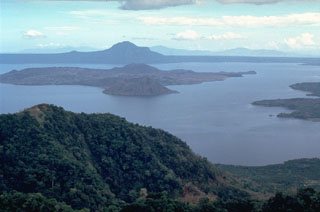Report on Taal (Philippines) — 2 October-8 October 2024
Smithsonian Institution / US Geological Survey
Weekly Volcanic Activity Report, 2 October-8 October 2024
Managing Editor: Sally Sennert.
Please cite this report as:
Global Volcanism Program, 2024. Report on Taal (Philippines) (Sennert, S, ed.). Weekly Volcanic Activity Report, 2 October-8 October 2024. Smithsonian Institution and US Geological Survey.
Taal
Philippines
14.0106°N, 120.9975°E; summit elev. 311 m
All times are local (unless otherwise noted)
Philippine Institute of Volcanology and Seismology (PHIVOLCS) issued advisories for Taal reporting that a total of 30 phreatic events were recorded almost daily during 22 September-5 October. Five phreatic events during the morning of 5 October were recorded by the seismic network. A minor phreatomagmatic eruption began at 1132 and lasted four minutes based on visual observations and seismic and infrasound data. The eruption ejected a short, black plume followed by a steam-rich plume that rose 2 km above the crater rim and drifted SW. Trace ashfall was reported in Agoncillo, Batangas, W of Taal Lake. Sulfur dioxide emissions averaged 2,068 tonnes per day (t/d) during 5-6 October and 1,267 t/d on 7 October, remaining at elevated levels. One small phreatic event was recorded during 6-7 October, and two phreatic events lasting 1-4 minutes long were recorded during 7-8 October. Hot fluids upwelling in the lake were observed during 5-8 October along with emissions that rose 900 m above the crater rim and drifted SW. The Alert Level remained at 1 (on a scale of 0-5), and PHIVOLCS reminded the public that the entire Taal Volcano Island was a Permanent Danger Zone (PDZ) and recommended that the Main Crater and areas along the Daang Kastila fissure should remain prohibited.
Geological Summary. Taal is one of the most active volcanoes in the Philippines and has produced some powerful eruptions. The 15 x 20 km Talisay (Taal) caldera is largely filled by Lake Taal, whose 267 km2 surface lies only 3 m above sea level. The maximum depth of the lake is 160 m, with several submerged eruptive centers. The 5-km-wide Volcano Island in north-central Lake Taal is the location of all observed eruptions. The island is composed of coalescing small stratovolcanoes, tuff rings, and scoria cones. Powerful pyroclastic flows and surges have caused many fatalities.
Source: Philippine Institute of Volcanology and Seismology (PHIVOLCS)

